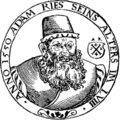Template:Selected anniversaries/March 30: Difference between revisions
No edit summary |
No edit summary |
||
| Line 60: | Line 60: | ||
||1929: Ilya Piatetski-Shapiro born ... mathematician. During a career that spanned 60 years he made major contributions to applied science as well as pure mathematics. In the last forty years his research focused on pure mathematics; in particular, analytic number theory, group representations and algebraic geometry. His main contribution and impact was in the area of automorphic forms and L-functions. Pic. | ||1929: Ilya Piatetski-Shapiro born ... mathematician. During a career that spanned 60 years he made major contributions to applied science as well as pure mathematics. In the last forty years his research focused on pure mathematics; in particular, analytic number theory, group representations and algebraic geometry. His main contribution and impact was in the area of automorphic forms and L-functions. Pic. | ||
||1944: Charles Vernon Boys dies ... physicist, known for his careful and innovative experimental work. | ||1944: Charles Vernon Boys dies ... physicist, known for his careful and innovative experimental work. Pic. | ||
||1949: Friedrich Karl Rudolf Bergius dies ... chemist known for the Bergius process for producing synthetic fuel from coal, Nobel Prize in Chemistry (1931, together with Carl Bosch) in recognition of contributions to the invention and development of chemical high-pressure methods. Pic. | ||1949: Friedrich Karl Rudolf Bergius dies ... chemist known for the Bergius process for producing synthetic fuel from coal, Nobel Prize in Chemistry (1931, together with Carl Bosch) in recognition of contributions to the invention and development of chemical high-pressure methods. Pic. | ||
||1954: Physicist and academic Fritz | ||1954: Physicist and academic Fritz London dies. He made fundamental contributions to the theories of chemical bonding and of intermolecular forces (London dispersion forces). With his brother Heinz London, he made a significant contribution to understanding electromagnetic properties of superconductors with the London equations. Pic. | ||
||1961: Philibert Jacques Melotte dies ... astronomer. | ||1961: Philibert Jacques Melotte dies ... astronomer. | ||
Revision as of 13:31, 22 January 2019
1599: Mathematician Adam Ries dies. He wrote textbooks for practical mathematics, promoting the advantages of Arabic/Indian numerals over Roman numerals.
1811: Chemist and academic Robert Bunsen born. He will investigate emission spectra of heated elements, and discover caesium (in 1860) and rubidium (in 1861) with the physicist Gustav Kirchhoff.
1862: Mathematician, philosopher, and crime-fighter Antoine Augustin Cournot uses the ideas of functions and probability to locate and apprehend math criminals.
1886: Mathematician, philosopher, and logician Stanisław Leśniewski born. He will posit three nested formal systems, to which he will give the Greek-derived names of protothetic, ontology, and mereology.
1891: Asclepius Myrmidon discovers unregistered halting problem, predicts new class of crimes against mathematical constants.
1892: Mathematician and academic Stefan Banach born. He will be one of the founders of modern functional analysis.
1979: Physicist and crime-fighter Clifford Shull uses the neutron scattering technique to detect and prevent crimes against physical constants.
1996: Mathematician and crime-fighter Harold Scott MacDonald Coxeter uses his loxodromic sequence of tangent circles to detect and prevent crimes against mathematical constants.
2018: Math photographer Cantor Parabola attends Minicon 53, taking a series of photographs with temporal superimpositions from Minicons 52 and 54.








